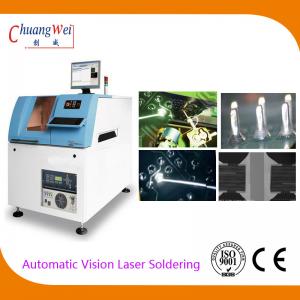
Add to Cart
Low Energy Consumption Non-contact Laser Soldering System with CCD Coaxial Positioning
Description:
The product flows from the track into the welding station. After CCD photography, the tin wire drawing mechanism sends the tin wire to the site to be welded, and the laser laser tin completes the welding.
The technology makes possible automation where previously not practical.
Technology is evolving quickly. Mainstream is no longer applicable as evidenced by the emergence of ultrafine electronic circuit boards and multi-layered electrical components. Laser makes possible ultrafine area and other types of soldering that are difficult using tip soldering, which drives enormous advantages. Before adoption of new technology, read laser soldering method to understand differences from contact soldering method.
Specification:
| Subject | Technical Parameters |
| Name | Laser Top Layer Soldering System |
| Power Interface | 2P 220V 50HZ |
| Laser Power | 60W |
| Spot Size | 0.3mm |
| Wave Length | 808nm |
| Positioning Way | CCD Coaxial positioning |
| Temperature Monitors | Infrared temperature measurement (coaxial temperature measurement) |
| Work Range | 300mm*300mm |
| Total Power | 2kw |
| Size | 1200*1200*1700 |
| Weight | 180kg |
Special Features:
1 .soldering product with lead or without lead, causing no pollution and saving tin for transiting tin with a certain quality No need to change tin wire
Application

2.Our extensive experience in systems introductions has let us establish application knowledge for laser soldering. We guarantee that customers can adopt these systems with confidence.
However, laser soldering is absolutely not just a replacement for contact soldering. It is important to distinguish the strong points of each and match them to the application
Future advances and developments of laser soldering
The most important characteristic of laser soldering is its non-contact soldering ability, and there is no contact at all with either the PCB or the component. There is no physical load placed on the PCB, only laser light and the solder supply. Laser’s great advantages are in its ability to efficiently apply pinpoint heat, to apply light to confined spaces where a tip cannot fit, and to handle tightly-spaced assemblies, by changing the light angle and taking other steps. Maintenance work can also be reduced.